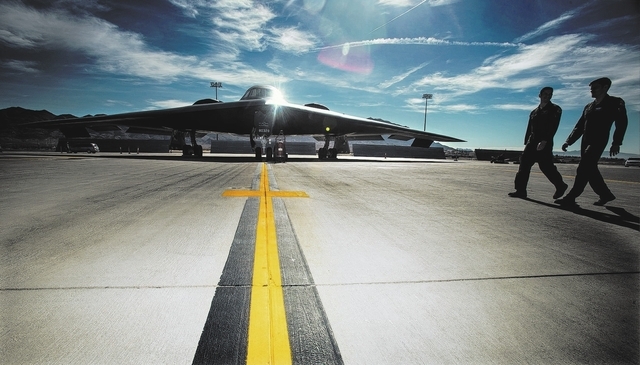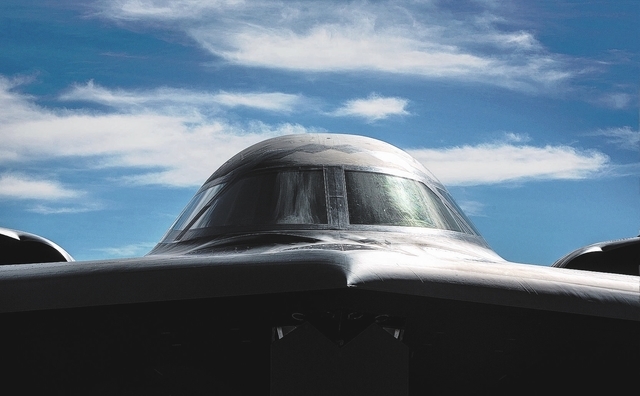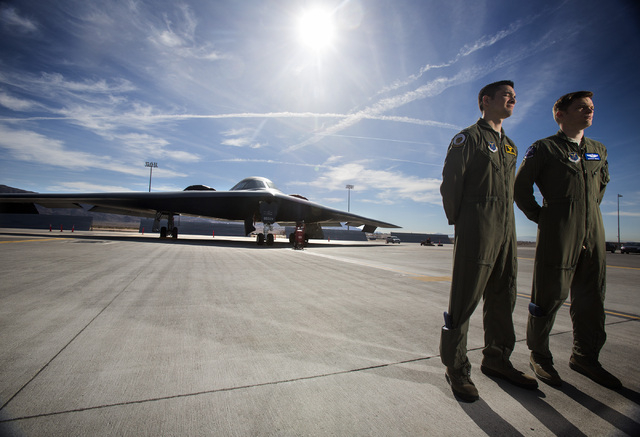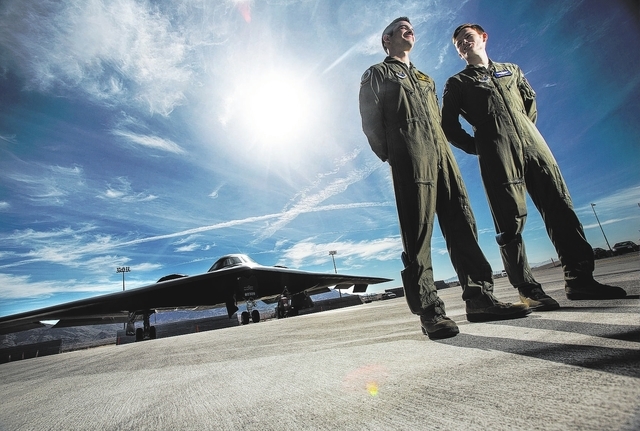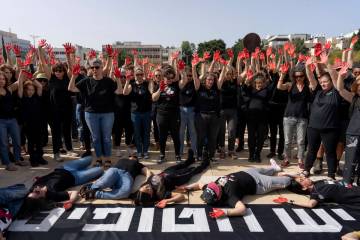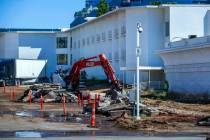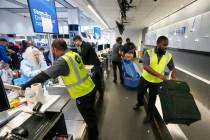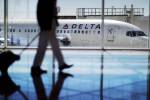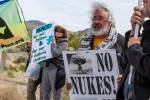Air Force shows off a big, black, brawny B-2 after Red Flag exercises at Nellis
After a rip-roaring Red Flag air combat exercise at Nellis last week, the bomb squad from Whiteman Air Force Base that steers the big, black, bat-shaped B-2 Spirit jets returned to Missouri.
With them they took lessons learned from flying mock war sorties with a mix of 100 U.S. and foreign warplanes.
“It’s the most realistic training we get without actually going to war,” said Capt. Garrett “Shredder” Bartee, a B-2 pilot from Lebanon, Ohio.
“You’re up there with a large force, almost a hundred aircraft at once flying in the same space at the same time,” he said Wednesday, standing in front of the Spirit of Texas. “At the same time, we’re simulating dropping bombs while other fliers are shooting missiles at other aircraft. So all of that is part of the simulation that you can’t get anywhere else.”
That B-2 with the Spirit of Ohio participated in the Red Flag that wrapped up Friday. They are two of 20 of the nation’s radar-evading B-2 stealth bombers, each costing up to $2 billion, depending on equipment, munitions and modifications.
Bartee said the B-2’s stealth technology makes it “difficult to see and target.”
“That allows us to hold enemy targets at risk around the world in almost any scenario you can imagine,” he said. “It almost goes without saying that if you can’t reach out and touch your enemy, then they’re really not going to care much about what you have to say. But, if you can fly just about anywhere in the world at any time and strike any target, it says something about what you can do with this aircraft,” Bartee said.
The training in the expanse of restricted airspace over the Air Force range more than 90 miles north of Las Vegas also helps them do their job to be ready to fly their nuclear-capable aircraft anywhere in the world at a moment’s notice.
“It’s absolutely important,” said Spirit of Texas pilot Capt. Colter “Dexter” White of Irving, Texas.
“Because it’s part of the (nuclear) triad — we’ve got bombers, we’ve got (intercontinental ballistic missiles), and we’ve got submarines — it allows us to continue to deter our adversaries to keep Americans safe and protect the Constitution,” he said.
“It allows us to continue to prosecute the war if, God forbid, there ever was one so we are able to continue to fight another day, so that we can continue to keep everything alive that we hold dear,” White said.
The B-2s from the 13th Bomb Squadron at Whiteman are part of the Air Force’s Global Strike Command based at Barksdale Air Force Base in Louisiana. The command is responsible for the nation’s three intercontinental ballistic missile wings, the two B-52 wings and the only B-2 wing. Their mission is to provide combat-ready forces for nuclear deterrence and global strike operations to support combatant commanders and the president.
Much of the B-2’s ability to strike depends not only on the two-person cockpit crew — a mission commander and pilot who use a fly-by-wire flight control system and a horde of high-tech instruments to steer and navigate the plane — but also on the ground crew that maintains the jet and ensures that it is always ready to fly.
“It’s a phenomenal aircraft,” crew chief Staff Sgt. Hayden Proffitt said. “There’s nothing that’s parallel to it that’s capable of doing what it can.”
As communication-navigation mission systems craftsman, Staff Sgt. Chris Mattingly has a daunting task.
“We perform daily inspections on the aircraft as well as our routine servicing — oil, fuel, hydraulic fluid,” Mattingly said. “We also remove and replace multiple parts on the aircraft to include tires, brakes, your engine starting system, things of that nature. We also perform trouble-shooting engine runs for certain discrepancies that come back with the aircraft.”
There has been one B-2 destroyed in a crash, the Spirit of Kansas, which went down on takeoff from Andersen Air Force Base in Guam in 2008. Both pilots ejected and survived. Investigators determined that moisture on sensors caused the crash when inaccurate data was transmitted to the flight-control computers.
Because of its range with airborne refueling, B-2s — with two pilots in a cockpit the size of two phone booths — have flown from their Missouri base to Afghanistan and back, a 44-hour marathon with combat in the middle. They first saw action over Serbia in the late 1990s during Operation Allied Force, flying nonstop to Kosovo and back.
In March 2011, a trio of B-2s of the 509th Bomb Wing struck 45 targets at an airfield in Ghardabiya, Libya, in the U.S.-led effort to protect civilians in that country’s civil war.
Instead of using nuclear weapons to quash a nuclear war, B-2s are more apt to unleash a barrage of precision-guided conventional bombs including some so massive and powerful they would snuff out enemy leaders by destroying command-and-control centers in the deepest and most hardened bunkers.
A B-2 can carry up to a 40,000-pound payload of various weapons such as sixteen 2,000-pound bombs, eight 5,000-pound bombs, eighty 500-pound bombs or thirty-four 1,000-pound cluster bombs. All are precision-guided munitions.
Because of its sensitive nature and classified details, there is little the Air Force has said publicly about the B-2’s nuclear weapons or its bunker-buster known as the MOP — Massive Ordnance Penetrator — or GBU-57.
But the MOP’s existence and 30,000-pound dimension is noted on a military information website, globalsecurity.org. And, a Wikipedia entry links its first test in 2007 to a Defense Threat Reduction Agency tunnel at the White Sands Missile Range in New Mexico. The agency is the same one that proposed to conduct the Divine Strake explosion at the Nevada Test Site, now the Nevada National Security Site.
The Divine Strake blast was to be the last and largest in a series of bunker-buster experiments using conventional chemical explosives designed to crush tunnels deep in limestone where an enemy could store weapons of mass destruction.
After opposition from environmentalists and politicians, the test was canceled in 2007 when the agency’s director, James Tegnelia, said he was “convinced that it’s time to look at alternative methods that obviate the need for this type of large-scale test.”
Nevertheless, the Air Force has such a bunker-buster in its arsenal, and the aircraft that can put it on its target is the B-2 Spirit.
“She flies beautifully for a large aircraft,” White said. “She rolls real nice. She’s got great stability. She does exactly what you ask of her, if you will. It’s a very smooth-flying aircraft. It employs weapons very well. You almost don’t feel them coming off the airplane.”



